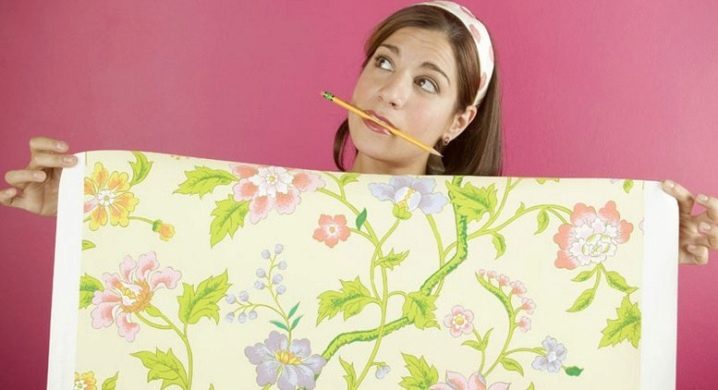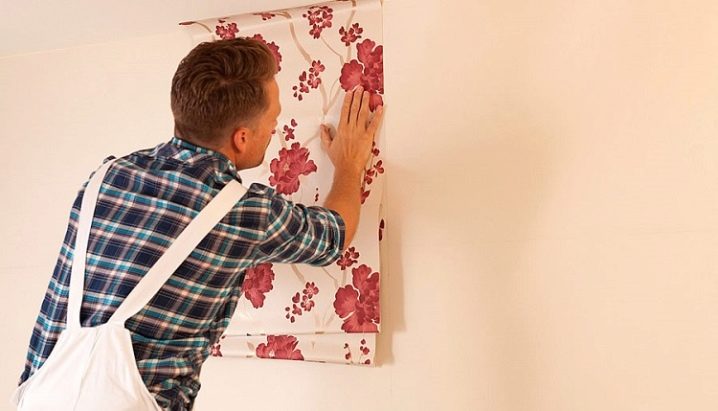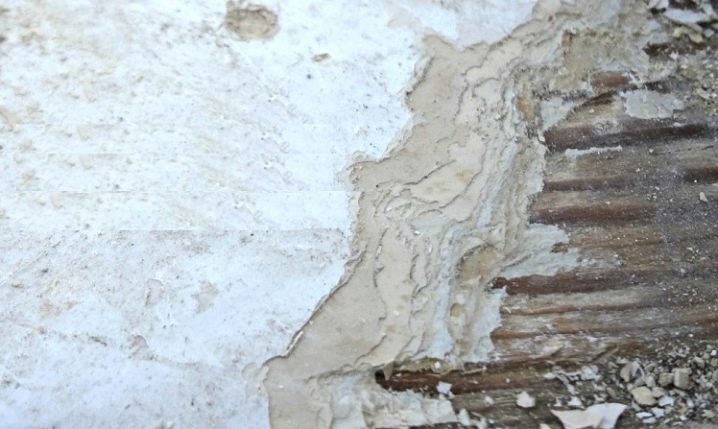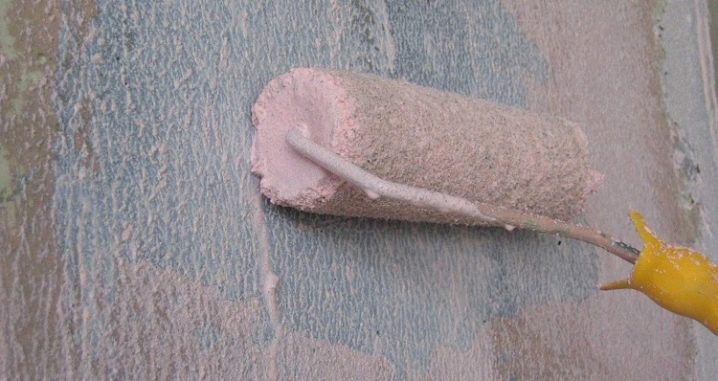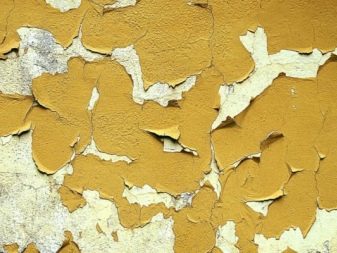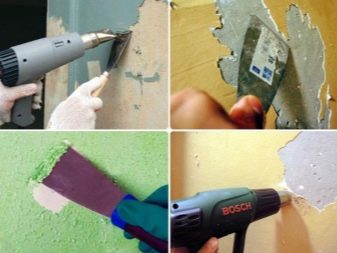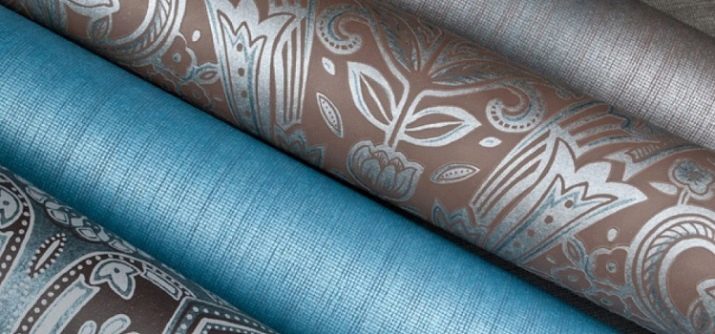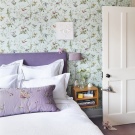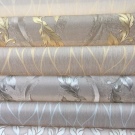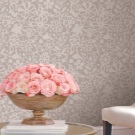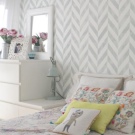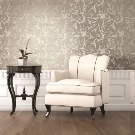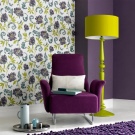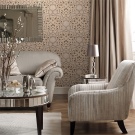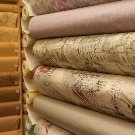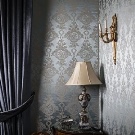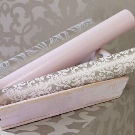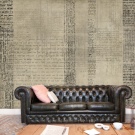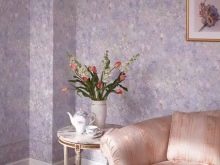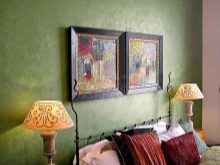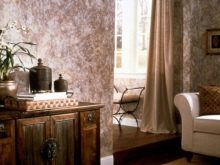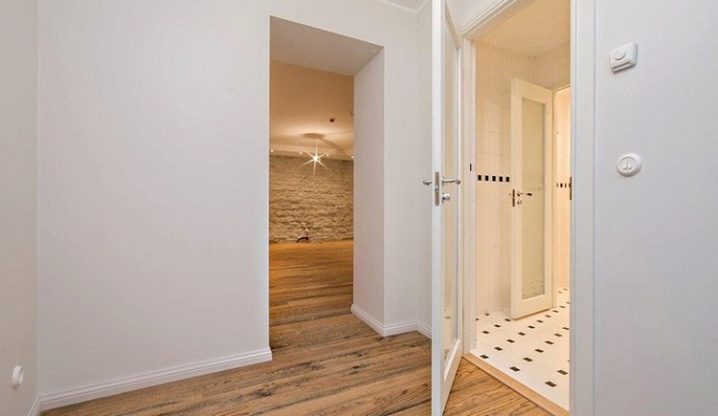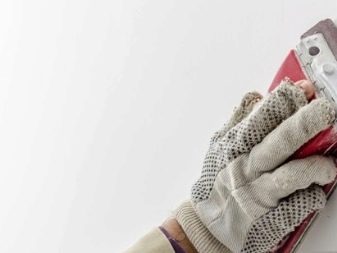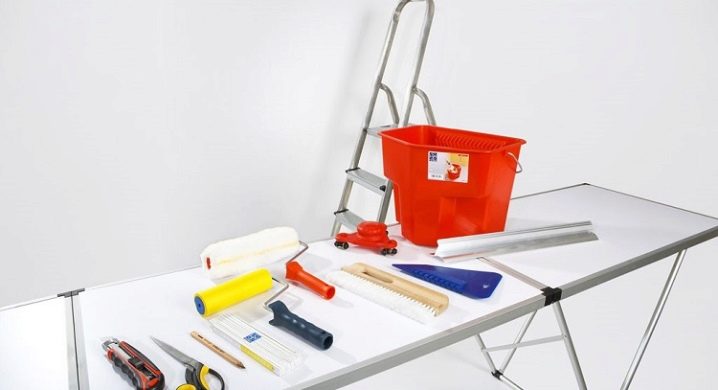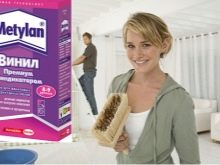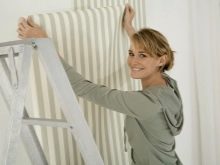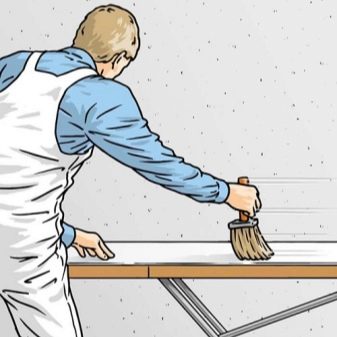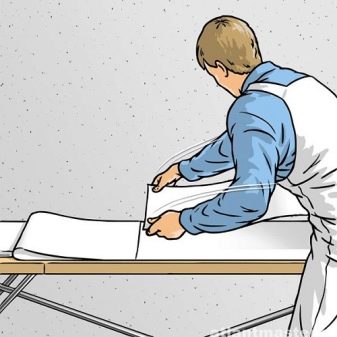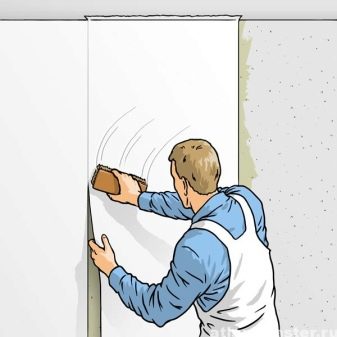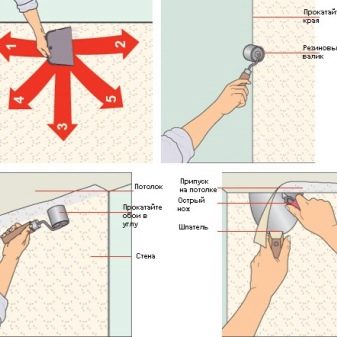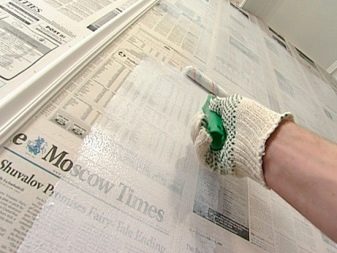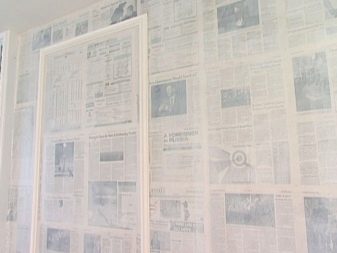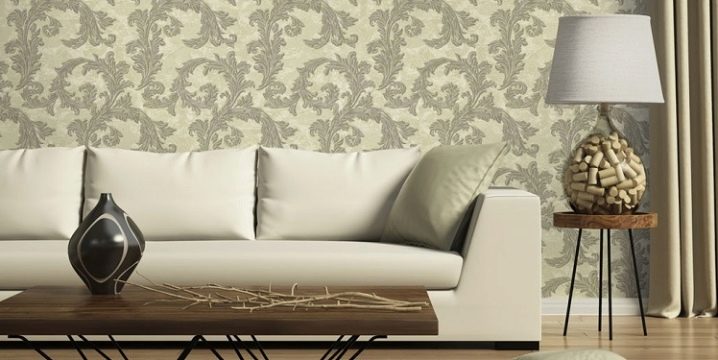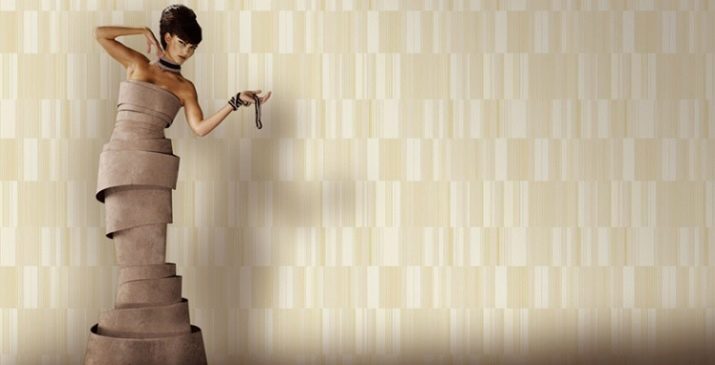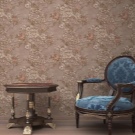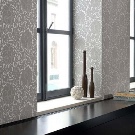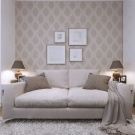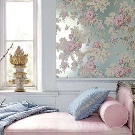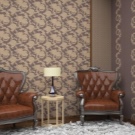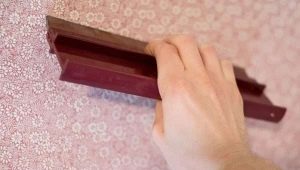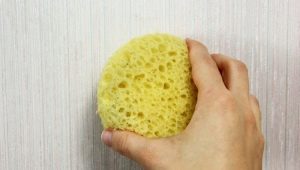Is it possible to glue wallpaper on water-based paint?
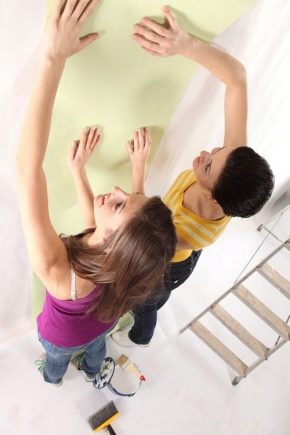
Painting the wall surface with water-based paint is one of the easiest and most costly methods of finishing. Due to the simplicity of work, some apartment owners decide to resort to this method of decorating walls. However, it happens that for the subsequent overhaul or redecoration, wallpapering is chosen. Is it necessary in this case not to “remove” the old coating and can we glue the canvases directly on the “water-based emulsion”? Let's figure it out.
Special features
Aqueous emulsion ink is a material related to water-dispersible formulations. Visually, they are emulsion containing water, pigment powder and a small amount of glue. This coating does not create a dense layer on the wall surface.It promotes the free circulation of steam and air, thereby creating a comfortable microclimate in the room.
A layer of water-based paint with the ingress of moisture is able to peel off. This leads to difficulties when applied to the water-based decorative wallpaper. However, in some situations it is allowed to glue the fabric directly on the paint:
- if the layer of the old coating is thin. To determine the thickness of the paint, peel off a small piece of paint from the wall. Is the coating layer thinner than a paper sheet? So you can safely glue wallpaper.
- If the walls were subjected to the same color. To determine the number of colors, you need, as in the previous case, to peel off the floor and look at the tones of the number of layers.
- If the covering keeps reliably on a wall: there are no chips, dimples and other deformations.
If one or several conditions coincide, you can glue the wallpaper on a waterproof water-based paint.
However, if you do not know what kind of coating applied to the walls, you need to determine its type.
Determine the type of paint
Before sticking wallpaper, you need to carefully examine the wall and determine what composition was used to paint it. The following types of paint could be used for interior decoration:
- oil
- Alkyd enamel.
- Water dispersion compositions.
If the surface of the wall is covered with oil paint or alkyd enamel, you should not risk and glue the wallpaper on them, because such compositions are characterized by poor adhesion to plaster. How to distinguish the oil composition and enamel from water dispersion?
The latter is showered when removed, has no smell and is thin. The oil base and enamel have a strong odor, have good water-repellent properties. From the surface, such paints are peeled off in large parts due to the whole thick layer.
Before glueing the wallpaper, the oil composition and enamel must be completely removed from the wall.
Choosing a wallpaper
Not all types of wallpaper can be glued to water-painted surfaces. It is best to abandon the gluing of simple paper and vinyl paintings. Take a closer look at:
- Cloths on non-woven fabric. You can glue non-woven wallpaper on painted walls, because such material quickly absorbs glue (before it penetrates the coating). Thus, the risks of excessive wetting and detachment of water-based whitewash are minimized.
- Fabric and vinyl cloths on a flizelinovy basis.Such materials look luxurious in any interior. They also have similar properties with conventional non-woven veneer.
- Liquid. To glue such material is not necessary. It is applied to the wall with a thin layer. The coating is characterized by rapid hardening. It does not have time to penetrate the paint and dissolve it. Liquid wallpaper is practical and convenient to use. They can even be glued to an uneven wall.
Paper and vinyl sheets are not recommended to be applied on the wall after painting. They quickly soak and dry for a long time, which is why there is a high risk of their peeling from the surface.
What needs to be considered?
Aqueous emulsion paint has a high adhesion. Thanks to this property, the material quickly and easily "engages" with putty and any other lining. However, sticking wallpaper is always accompanied by risks: the canvases can “move away” and you have to spend money again on the purchase of new material, and make efforts to finish.
To avoid the above problems, It is recommended to completely clean the walls from the old coating. On the prepared surface, you can safely glue the wallpaper, without fear of the appearance of bubbles below them or the detachment of the previous finishing material. The process of removing the old paint is simple.For this you need a container with warm water, a hard sponge or a terry towel.
The surface needs to be wetted and rinsed off water dispersion paint with rags. When carrying out work, it is recommended to frequently replace dirty water with clean water and to rinse the rag well.
Preparatory activities
It happens that at their own risk and risk the owners decide to leave a layer of old paint. If there are no cracks, “blisters”, chips and delaminations on the surface, then it is still necessary to do without preliminary preparation of the base. To keep the wallpaper firmly and securely they cannot be glued immediately to painted walls over acrylic water emulsion. The surface must be processed.
The procedure includes several steps:
- Surface treatment with coarse sandpaper. Walk through the entire area of the wall with a coarse-grained “nazhanchkoy”, leaving roughness. Thanks to grinding, you will get rid of irregularities, accumulated dirt and dust. Such work should not be neglected, even if visually the wall looks perfectly smooth.
- Coating the base with a primer. Polished wall surfaces are recommended to be treated with a ground compound.Thanks to him, it will be possible to improve the quality of adhesion of the wall and wallpaper. On the primer can be glued to any type of wallpaper. When choosing a product it is best to opt for a composition with antiseptic properties. Such a soil will prevent the occurrence and reproduction of fungi.
It is recommended to glue wallpaper only the next day after applying the primer.
Necessary inventory
Before finishing activities you need to prepare materials and tools in advance. For the work will need:
- Building level to make the necessary measurements.
- Roller or brush for applying adhesive composition.
- Stepladder for high-altitude work.
- Pencil for marking.
- Scissors or stationery cutter for cutting sheets.
- Rubber roller for removing air bubbles.
Thanks to proper preparation for wallpapering, you can speed up and simplify the workflow.
How to stick?
Before you begin to glue the wall, you need to read the instructions attached to the purchased wallpaper. Often it gives advice and recommendations on the correct installation of the material.Also, some manufacturers indicate how to apply glue, how long it will take to dry the lining, whether it is necessary to customize the picture and other important information. After reading the information from the manufacturer, you can start working. Follow the steps below:
- Dilute the glue with water in accordance with the instructions on the package. If you plan to finish the walls with heavy wallpaper, you should add PVA glue (from a 1: 1 ratio to the dry mix).
- Mark the desired length of the wallpaper, cut the layer and place the sheet face down.
- Apply adhesive composition from the center to the periphery of the sheet. Try to paint the entire surface. Allow a little time to soak the canvas with glue.
- Lift the sheet, lean its upper part against the ceiling. Align the line and gently press the canvas to the wall from top to bottom (smooth the wallpaper with your hand movements from the center of the sheet to its edges).
- Dab off the glue with a soft cloth.
- If in the process of stickers bubbles formed, expel them using a roller or a special spatula, equipped with a rubber tip.
Observing this procedure, you can quickly and smoothly stick the canvas, and avoid their subsequent detachment from the wall.
Recommendations
These tips will help to prevent mistakes when sticking wallpaper on a wall painted with a water emulsion:
- If you plan to veneer the surface with heavy cloths, it is recommended to pre-paste special paper on the substrate. Please note that paper seams and wallpaper joints should not be the same.
- If you want to glue the fabric on painted plywood with a water emulsion, you must first cover the base with a composition made from soil and glue (1: 1 ratio).
- Before you stick the canvas, conduct an experiment: stick a regular newspaper to the surface of the wall and after drying, try to tear it off. If the paper will “lag behind” with difficulty, you can safely trim the base. Otherwise, it is recommended to completely wash away the layer of the old lining.
- Do not tear off the sheet of wallpaper to get rid of air bubbles. Use paint roller. Tearing off the web can lead to a splitting of the “water emulsion” and a weak subsequent adhesion of the sheet to the wall.
- When carrying out repairs in the winter you need to turn off the battery.The increased air temperature will contribute to the drying of the wallpaper and the possible divergence of the seams.
- When sticking sheets try to avoid drafts. Close the windows and doors in the room in which the finishing work.
- Do not glue wallpaper on a damp, dusty or dirty surface.
Armed with these tips and recommendations, you can get down to business. Observe the order of actions - so you can minimize the risks of making mistakes and make high-quality cosmetic repairs.
Successful examples and options
Sticking wallpaper on walls that have been painted with paint requires certain actions. By doing this, you can achieve high results. Most often, an aqueous emulsion composition covers the walls in kitchens and dining rooms. This has its advantages, for example, such a coating is easy to care for, just wipe it with a damp cloth. However, if you stick a washable wallpaper in this area, you can achieve greater decoration.
Whatever wallpaper is chosen, in order to properly stick them to the wall, painted with water-based paint, you must first prepare the surface and then the new coating will last a long time.
About how to give preference, see the next video.
